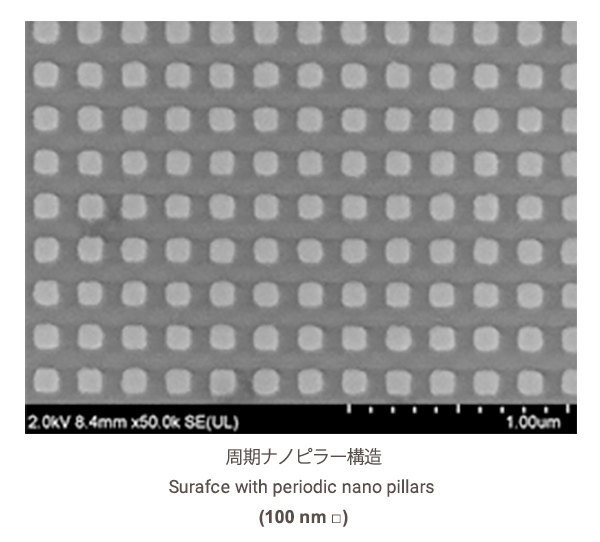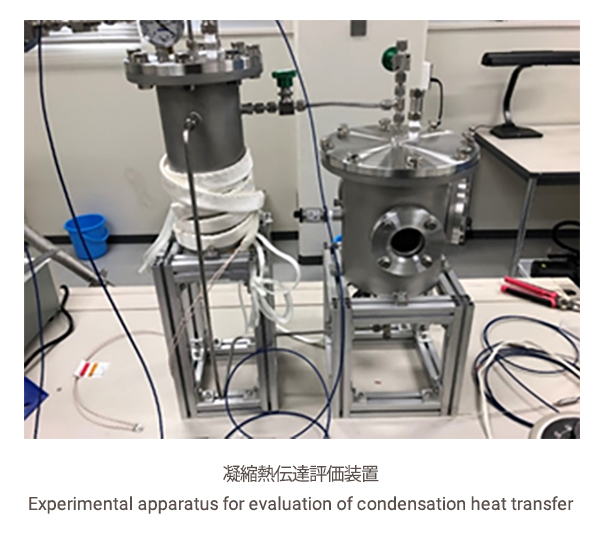Research
Influences of nanostrutures on interfacial energy transfer




The interfacial thermal resistance between the fluid and the solid changes by modifying the heat transfer surface at the molecular scale or by imparting nano-microstructures. In this study, in order to optimize the nano-microstructures by surface modification, we are investigating how the local region of the microstructure affects the interfacial thermal resistance between fluid and solid, or the nucleation during phase change by means of molecular dynamics simulations and experiments.
K. Nakamura et al.,JSME Kansai-District Conferene(2022).
M. Shibahara, A. Fujii, 8th Asian Symposium on Computational Heat Transfer and Fluid Flow (2021).
Z. Jiang, M. Shibahara, 8th Asian Symposium on Computational Heat Transfer and Fluid Flow (2021).
A. Fujii, K. Fujiwara, Y. Ueki, M. Shibahara, J. Therm. Sci. Tech., Vol.15, No.1, Paper No.20-00145, (2020).
D. Surblys, Y. Kawagoe, M. Shibahara, T. Ohara, J. Chem. Phys. , 150, 114705 (2019).
Y. Ueki, Y. Miyazaki, M. Shibahara, T. Ohara, Int. J. Heat Mass Trans., 120, 608-623 (2018).
Influences of nanostrutures on frost formation


It is known that the performance of heat exchangers below 0 degree C is significantly reduced by frost formation. In this study, the effects of wettability and nano-microstructure addition on the heat transfer surface on the solidification process of water droplets are investigate by means of molecular dynamics simulations in order to study the possibilities of the basic process control of frost formation by surface characteristics.
R.Kashiwagi et al., JSME Kansai District Conference (2022).
Y. Ueki, Y. Tsutsumi, M. Shibahara, 2nd Asian Conference on Thermal Sciences (2021).
Energy transfer mechanism of nanofluids

It is expected that a liquid in which nanoparticles are suspended will be used to improve the thermophysical properties of the working fluid. In this study, we experimentally measure the thermal conductivity and specific heat of liquids in which various nanoparticles are suspended, and investigate the mechanism of the change in thermophysical properties in detail by molecular dynamics simulation.
M. Shibahara et al., HTSJ Symposium (2021).
K. Fujiwara, M. Daimo, Y. Ueki, T. Ohara, and M. Shibahara, International Journal of Heat and Mass Transfer, 144, 118695, (2019).
Y. Ueki, K. Ueda, M. Shibahara, International Journal of Heat and Mass Transfer,127, 138-144 (2018).
Y. Ueki, N. Fujita, M. Kawai, M. Shibahara,Fusion Engineering and Design, 136, 1295-129 (2018).
Molecular dynamics simulation on energy transfer of reactive flow

Simulation of fluids involving reactions and heat transport has become important for optimizing catalyst structures and designing nanomicroscale devices. In this study, we are elucidating the coupled phenomenon of reactivity and thermal transport by means of molecular dynamics simulation for various industrially important flows with reaction and thermal transport.
Masahiko Shibahara and Masashi Katsuki, Combustion and Flame, Vol. 144, pp.17-23, (2006).
Y. Fujii, et al., Thermal Engineering Conference, (2021).
Modeling of contact thermal resistance and heat transfer analysis of complex systems

With technological innovation such as electrification and nanomicronization, thermal design of new systems with complicated structures is required. In this research, we aim to create a simple simulation model that can predict the temperature change of each part while modeling the contact thermal resistance of each part appropriately.
Heat and Fluid Flow x Acoustic Measurement x Machine Learning

There are a lot of sounds around us. The sounds are waves, and emitted based on certain physics. Boiling sound is one of good examples in the heat and fluid flow (thermofluid). Listen to the thermofluid, and then we will be able to know their physical states. In addition to it, we can utilize machine learning and it find the useful information that human being could not find or interpret. We currently study the machine learning approach to realize the physical state detection of the thermofluid.
N. Mikami et al., JSME Kansai District Conference (2022).
Y. Ueki et al., International Communication of Heat and Mass Transfer (2021).
M. Miyake et al., JSME TED Conference (2021).
Y. Ueki et al., HTSJ Symposium (2021).
Y. Ueki et al., JSME Annual Conference (2020).
Nanoscale Evaporation and Gas-Liquid Interface

Evaporation has high efficiency in heat transport, and is utilized in a wide range of industrial thermal equipment. In the future, the thermal equipment will be further downsized and improved in thermal efficiency. Based on this, we investigate molecular-scale/nanoscale evaporation phenomena by using molecular simulations and experimental instruments.
H. Shiga et al., JSME Kansai District Conference (2022) .
Y. Ueki et al., 3rd International Conference of Microfluidics, Nanofluidics and Lab-on-a-Chip (2021).
Y. Isobe et al., JSME TED Conference (2021).
H. Shiga et al., JSME Kansai-District Conference (2021).
Y. Ueki, H. Murashima, M. Shibahara, International Journal of Heat and Mass Transfer 163, 120463 (2020).




